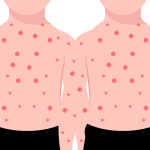A study in The Lancet in April 2024 reveals that the use of microarray patches for vaccination is “safe and effective” as the technology has been “ranked as the highest global priority innovation” to tackle immunisation barriers in LMICs. The trial provides data on the tolerability, safety, and immunogenicity of a measles and rubella vaccine (MRV) in children in The Gambia. Led by researchers from the London School of Hygiene & Tropical Medicine (LSHTM) and supported by the US CDC, the trial used devices developed and manufactured by Micron Biomedical and was funded by the Bill & Melinda Gates Foundation.
Tackling measles and rubella
The authors attribute “substantial progress” in reducing the global burden of measles and rubella to vaccination; between 2000 and 2021 the annual number of measles deaths has been reduced by “around 83%” and an estimated 56 million measles deaths have been averted in this time. In 2020, the annual number of rubella cases fell by 96% to 10,194. WHO’s six regions have committed to measles elimination, with WHO recommending that countries “consistently achieve” at least 95% two-dose measles vaccine coverage.
Between 2000 and 2019, first dose measles vaccine coverage increased to 86% across the world, with coverage in the WHO African region increasing from 53% to 70%. While second dose measles vaccine coverage was 71% globally in 2021, it was only 41% in the WHO African region. Additionally, the authors identify “significant heterogeneity both between and within countries”.
Thus, periodic supplementary immunisation activities (SIA), targeting an entire population (usually children between the ages of 9 months and <5 years) during intensive campaign periods, “continue to be necessary” to increase population immunity and respond to measles outbreaks. In 2021 over 150 million children received measles vaccines through SIA.
“Such vertical approaches tend to improve coverage equity compared with routine immunisation services, which vulnerable people have the most difficulty in accessing.”
However, SIA are “personnel intensive, logistically complex, and variable in their capacity” to reach zero-dose children. Therefore, alternative strategies are needed. Microneedle patches (MNPs) could provide “programmatic advantages” over conventional needle and syringe approaches. This potential has been identified by the Vaccine Innovation Prioritisation Strategy, which ranked the developed of MNPs the highest global priority for achieving equity of vaccine coverage.
MRV-MNP in trial
The trial used an MRV-MNP that contains live-attenuated MRV embedded in an array of microneedles, which penetrate the epidermis and upper dermis, dissolve, and release the vaccine. The application is “designed to allow for administration by people who are not healthcare professionals” and is a “largely painless” process. Furthermore, MRV-MNPs are “expected to have” improved thermostability, and wastage is minimised.
The trial was a single-centre, Phase I/II, double-blind, double-dummy, randomised, active-controlled, age de-escalation trail, conducted in The Gambia. Participants were recruited between May 2021 and May 2022, with 45 adults, 120 toddlers, and 120 infants randomly allocated and vaccinated.
The trial offers the first data on the use of MNP in vaccine administration to children. In adults, toddlers, and infants, the MRV-MNP was “well tolerated and safe”, and the immunogenicity was “similar” to that of a needle and syringe vaccine. As the vaccine viruses were delivered “directly” into the skin, mild local reactions at application sites were “more frequent” than at the subcutaneous injection site.
Researchers have hope
The researchers at LSHTM “hope” that microarray patches could help to achieve “very high levels of population immunity” to control diseases like measles and rubella. Professor Ed Clarke leads the Vaccines and Immunity Theme at MRC Unit The Gambia and is a co-author who commented that the “extremely promising results” have “generated a lot of excitement”.
“They demonstrate for the first time that vaccines can be safely and effectively given to babies and young children using microarray patch technology. Measles vaccines are the highest priority for delivery using this approach but the speed of other vaccines using microarray patches is also now realistic. Watch this space.”
Dr Ikechukwu Adigweme, co-author from the Vaccines and Immunity Theme at MRC Unit The Gambia finds these “positive” results “quite gratifying to us as a team”.
“We hope this is an important step in the march towards greater vaccine equity among disadvantaged populations.”
Larger trials are now expected, with hopes high for further confirmation of these early results. For more on vaccine technology and the ways it can be implemented for wide coverage, don’t forget to subscribe to our newsletters here.





